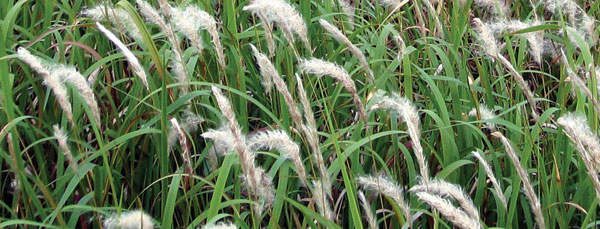Extracts

Cogongrass Becoming Worse Than Kudzu
Mickie Anderson
And you thought kudzu was bad.
A weed called cogongrass is rapidly spreading across the Southeast, and a University of Florida researcher said it’s already overtaken kudzu as Florida’s most obnoxious weed.
“Kudzu’s no longer the poster child. Cogongrass is a big deal,” said forestry researcher Shibu Jose. “It’s becoming a major, major problem.”
Cogongrass (CO-gun-grass) has yellowish-green foliage and can reach 4 feet tall, said Jose, of UF’s Institute of Food and Agricultural Sciences.
Introduced into Alabama from Japan as a packing material in 1912, cogongrass was tested as a forage crop in the 1920s, which allowed it to gain a toehold. It began making its presence known in the 1970s and 1980s, Jose said, and is now causing problems in Louisiana, Mississippi, Alabama, Georgia and Florida.
A 2003 survey showed 1.5 million acres of cogongrass across the Southeast, compared to 1 million acres of kudzu, Jose said. Florida has about a half-million acres of cogongrass.
Cogongrass is well-suited to its role as an aggressive weed. It’s a perennial that can spread quickly underground, its roots easily besting other plants for water, nutrients and space.
Cogongrass also thrives where fire is a regular occurrence. Jose believes recent wildfires may make the problem worse, because fires kill smaller trees and plants, leaving lots of room for cogongrass to move in and take over.
When cogongrass squeezes out native plants, it can hurt animals that depend on those plants for food or shelter.
Jose, who published a paper on cogongrass in the June issue of the journal Biological Invasions, has been studying the grass for about nine years.
Some Florida counties, such as Alachua and Marion, are making a concerted effort to bring everyone from government officials to landowners to researchers together to eradicate cogongrass. But the entire state must be on board, he said.
“It doesn’t do any good if everyone’s not doing the treatments. Private landowners, agencies, et cetera—everyone has to work together,” he said. “If we don’t do this, we will see cogongrass everywhere.”
Cogongrass can be controlled, but it takes a specific regimen of mowing and controlled burns, coupled with repeated, well-timed herbicide treatments, he said.
UF researchers are looking for a biological control solution for cogongrass, but so far, that’s been elusive, said UF plant pathology Professor Raghavan Charudattan.